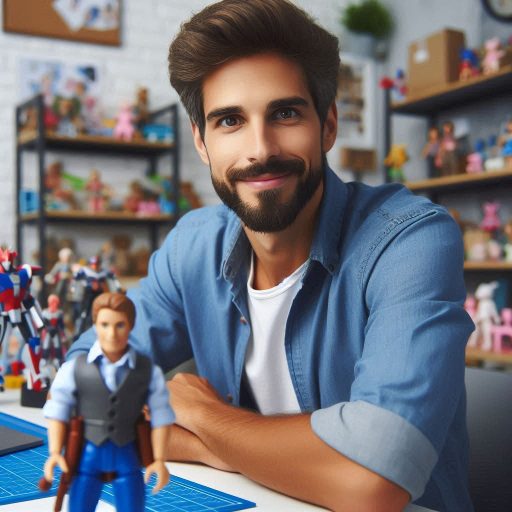Introduction
Toy design and development offers a unique career path for creative individuals.
This field combines art, engineering, and marketing to create engaging products.
Designers craft toys that spark imagination and promote learning.
They think outside the box to develop innovative concepts and features.
Creativity is the heart of toy design. Professionals often sketch ideas, build prototypes, and test their creations.
They explore different materials and technologies to enhance play experiences.
Innovation drives this industry forward, as designers must stay updated on trends and consumer preferences.
The demand for skilled professionals in the toy industry is growing.
As parents increasingly prioritize educational and developmental toys, companies seek talented individuals.
This demand opens doors for careers in design, engineering, and marketing.
Toy designers play a crucial role in shaping children‘s experiences.
They create products that entertain and educate, promoting social interaction and cognitive development.
With the rise of technology, the toy industry also embraces digital platforms, creating exciting opportunities for designers.
In essence, a career in toy design and development is both fulfilling and dynamic.
It requires a blend of creativity and technical skills.
Aspiring designers can find numerous opportunities to leave a lasting impact on children‘s lives.
Embrace your passion for creativity and innovation in this vibrant field.
Overview of Toy Design and Development
Role of a toy designer in creating new and engaging toys for children
Toy designers play a crucial role in creating new and engaging toys for children.
They are responsible for transforming ideas into tangible products that bring joy and entertainment to kids.
To excel in this field, toy designers need to possess a unique blend of creativity, technical skills, and a deep understanding of child development.
Transform Your Career Today
Unlock a personalized career strategy that drives real results. Get tailored advice and a roadmap designed just for you.
Start NowThey must be able to think outside the box and come up with innovative concepts that capture the imagination of young minds.
Skills and Qualifications Needed for a Career in Toy Design
- Creative Thinking: Toy designers must have a creative mindset and the ability to generate fresh ideas.
- Technical Skills: Knowledge of design software and 3D modeling is essential in creating prototypes.
- Understanding of Child Development: A background in child psychology or education can be beneficial in designing age-appropriate toys.
- Communication Skills: Toy designers need to collaborate with cross-functional teams and effectively communicate their vision.
- Attention to Detail: It’s crucial to pay attention to small details to ensure the safety and quality of toys.
Different Stages of Toy Development
- Concept Creation: This stage involves brainstorming ideas, sketching designs, and creating prototypes to bring the concept to life.
- Market Research: Toy designers need to conduct market research to understand consumer preferences and trends in the industry.
- Testing and Feedback: Once a prototype is developed, it undergoes testing with target users to gather feedback for improvement.
- Production: After finalizing the design, the toy goes into mass production where quality control is crucial to ensure consistency.
- Marketing and Distribution: Toy designers work with marketing teams to promote and distribute the product through various channels.
In fact, toy design and development is a dynamic and rewarding career path that allows individuals to combine their creativity with technical skills to create products that bring joy to children worldwide.
Read: Toy Design Portfolios: Tips for Success
Educational Requirements
Choosing the right educational pathway is crucial for those aspiring to become successful toy designers.
Here is a breakdown of the educational requirements and the steps one must take to pursue a career in toy design and development.
Degree in Industrial Design or Related Field
One common educational route for aspiring toy designers is to obtain a degree in industrial design.
This program typically covers design principles, materials, manufacturing processes, and prototyping techniques.
It provides a solid foundation for designing products, including toys.
Specialized Degree in Toy Design
Some universities offer specialized programs in toy design, focusing specifically on the unique challenges and requirements of designing toys.
These programs often include courses in toy safety regulations, child development, and play research.
Importance of Hands-On Experience
While a formal education is essential, gaining hands-on experience through internships or co-op programs is equally important.
This practical experience allows aspiring toy designers to apply their knowledge in real-world settings, build their portfolios, and make valuable industry connections.
Staying Updated on Industry Trends
Toy design is a constantly evolving field, with new trends, technologies, and consumer preferences emerging regularly.
For this reason, continuous learning and staying updated on industry trends are critical for success.
Attending workshops, conferences, and trade shows can help toy designers stay ahead of the curve and remain competitive in the industry.
Professional Development Opportunities
Professional organizations such as the Toy Association offer valuable resources and networking opportunities for toy designers.
Membership in these organizations allows designers to access industry news, job postings, and professional development opportunities, further enhancing their skills and knowledge.
In short, pursuing a career in toy design and development requires a combination of formal education, hands-on experience, and a commitment to continuous learning and professional development.
By following the right educational pathway, gaining practical experience, and staying informed about industry trends, aspiring toy designers can position themselves for success in this exciting and dynamic field.
Read: Famous Toy Designers You Should Know About
Transform Your Career Today
Unlock a personalized career strategy that drives real results. Get tailored advice and a roadmap designed just for you.
Start NowCareer Opportunities in Toy Design
When considering a career in toy design and development, it’s essential to explore the various opportunities that exist within this industry.
Whether you’re interested in working for established toy companies, design studios, or pursuing freelance projects, there are a range of career paths to choose from.
Various career opportunities available to toy designers
Working for Toy Companies
Many toy designers begin their careers by working for well-known toy companies such as Hasbro, Mattel, or LEGO.
These companies offer a structured environment where designers can gain valuable experience working on a variety of projects and collaborating with cross-functional teams.
Design Studios
Design studios provide an alternative path for toy designers who prefer a more creative and collaborative working environment.
These studios often work with a range of clients in various industries, allowing designers to diversify their portfolios and explore different design aesthetics.
Freelance Work
For those who prefer flexibility and autonomy in their work, freelance opportunities in toy design can be an excellent choice.
Freelancers have the freedom to choose their projects and clients, as well as set their own schedules and rates.
Potential for Advancement
Lead Designer
Experienced toy designers may have the opportunity to advance to a lead designer role, where they oversee and guide junior designers in the development of new toy concepts.
This role requires strong leadership skills and a keen eye for design.
Starting Your Own Toy Design Firm
For those with an entrepreneurial spirit, starting your own toy design firm can be a rewarding career choice.
This path offers the opportunity to create your own brand, develop innovative toy concepts, and build a team of talented designers to bring your ideas to life.
International Opportunities
Global Demand for Toy Designers
As the toy industry continues to grow and evolve, there is an increasing demand for talented toy designers on a global scale.
International companies often seek out designers with diverse perspectives and cultural influences to create innovative and marketable products.
Collaborating with International Partners
Toy designers who are open to collaborating with international partners can expand their networks and reach new audiences.
Working with overseas manufacturers, distributors, and retailers can provide valuable insights into different markets and consumer preferences.
Overall, the field of toy design and development offers a wealth of opportunities for creative individuals who are passionate about bringing joy and imagination to children around the world.
Whether you choose to work for a company, start your own firm, or pursue international collaborations, there is no shortage of ways to thrive and succeed in this dynamic and exciting industry.
Read: Must-Have Tools for Toy Designers

Salary and Job Outlook
Toy designers play a vital role in creating products that inspire joy and creativity.
Transform Your Career Today
Unlock a personalized career strategy that drives real results. Get tailored advice and a roadmap designed just for you.
Start NowUnderstanding their salary range and job outlook can help aspiring professionals gauge their potential in this field.
Average salary range for toy designers, including factors that can affect earnings
The average salary for toy designers typically ranges from $50,000 to $80,000 annually.
Entry-level positions may start at around $40,000, while experienced designers can earn upwards of $100,000.
Various factors influence earnings, including location, level of education, and the designer’s experience.
Designers in major metropolitan areas often earn higher salaries due to the cost of living and greater demand for creative talent.
Additionally, those with specialized skills in areas like engineering or digital design may command higher pay.
Job outlook for toy designers, including the expected growth in the industry
The job outlook for toy designers remains positive.
The U.S. Bureau of Labor Statistics projects a growth rate of 4% for industrial designers, which includes toy designers, from 2021 to 2031.
This growth reflects a consistent demand for innovative toys that engage children’s imaginations.
The rise of technology, including educational and electronic toys, drives this demand.
Companies are eager to attract talented designers who can create captivating and educational products.
Potential for financial success and job satisfaction in a career in toy design and development
Financial success in toy design is achievable for dedicated individuals.
Many designers find joy in their work, combining creativity and functionality.
This blend often leads to high job satisfaction.
Designers contribute to making children‘s lives more enjoyable while developing products that foster learning and creativity.
Those who thrive on innovation and collaboration will find numerous opportunities to excel.
In general, a career in toy design offers promising financial prospects and personal fulfillment.
The combination of competitive salaries and a growing industry makes this a rewarding career choice for creative individuals.
Read: From Concept to Creation: Toy Design Process
Challenges and Rewards
When it comes to a career in toy design and development, there are both challenges and rewards that come with the territory.
Transform Your Career Today
Unlock a personalized career strategy that drives real results. Get tailored advice and a roadmap designed just for you.
Start NowLet’s delve into what toy designers may face in their profession and the fulfilling aspects that make this career worthwhile.
Challenges
- Tight Deadlines: Toy designers often have to work under tight deadlines to meet product launch dates and keep up with market demand.
- Budget Constraints: Designing and developing toys can be expensive, and staying within budget while ensuring quality can be a challenge.
- Competition: The toy industry is highly competitive, with new trends and innovations constantly emerging, making it challenging to stand out.
These challenges can create a high-pressure environment for toy designers, requiring them to think creatively and strategically to overcome obstacles and deliver successful products.
Rewards
- Bringing Joy and Creativity: One of the most rewarding aspects of a career in toy design is the opportunity to bring joy and spark creativity in children’s lives through innovative and engaging toys.
- Personal Fulfillment: There is a sense of personal fulfillment that comes with seeing a child’s eyes light up while playing with a toy that you helped create.
- Sense of Accomplishment: Successfully designing and launching a toy that resonates with consumers and becomes a hit in the market can bring a strong sense of accomplishment to toy designers.
Overall, despite the challenges that toy designers may face, the rewards of creating toys that bring happiness and inspiration to children’s lives make this career path incredibly fulfilling and worthwhile.
See Related Content: Top Fashion Design Competitions to Enter
Interview with a Toy Designer
Meet Sarah, a seasoned toy designer with over a decade of experience in the industry.
She shares her insights, experiences, and advice for aspiring toy designers.
Career Path
Sarah started as a graphic designer but found her passion for toy design while working on a project for a toy company.
She pursued a degree in industrial design to specialize in toy design and landed her first job at a toy manufacturing company.
Over the years, Sarah worked her way up from a junior designer to a senior design manager, overseeing product development.
Experiences
Sarah highlights the collaborative nature of toy design, working closely with engineers, marketers, and manufacturers.
She emphasizes the importance of creativity, attention to detail, and understanding child psychology in designing successful toys.
Sarah also mentions the joy of seeing children’s faces light up when they interact with a toy she helped create.
Advice for Aspiring Toy Designers
Develop your drawing and prototyping skills to bring your ideas to life and communicate them effectively.
Network with industry professionals, attend toy fairs, and stay updated on the latest trends in toy design.
Be open to feedback and learn from your mistakes to continuously improve and grow as a designer.
Challenges and Rewards
Sarah acknowledges the competitive nature of the toy industry, with constantly evolving trends and market demands.
She finds fulfillment in overcoming design challenges, finding innovative solutions, and creating memorable toys that resonate with children.
Seeing a child’s imagination sparked by a toy she designed is one of the most rewarding aspects of Sarah’s career.
Tips for Building a Successful Career
- Build a strong portfolio showcasing your diverse range of toy designs, from conceptual sketches to final products.
- Seek mentorship from experienced designers and learn from their experiences to accelerate your career growth.
- Stay curious, keep experimenting with new ideas, and never lose sight of the joy and wonder that toys bring to children’s lives.
You Might Also Like: Effective Communication for Creative Directors
Conclusion
Pursuing a career in toy design and development can be a rewarding and exciting journey.
Transform Your Career Today
Unlock a personalized career strategy that drives real results. Get tailored advice and a roadmap designed just for you.
Start NowThe key points discussed in this blog post highlight the creativity, passion, and perseverance required in this field.
It is essential to possess a love for toys and a drive to bring imagination to life.
Creativity is at the heart of toy design, and it is crucial to continuously explore new ideas and innovate.
Passion fuels the commitment needed to overcome challenges and setbacks in the industry.
Perseverance is key to pushing through obstacles and achieving success in toy design and development.
Aspiring toy designers should embrace their creative instincts, hone their skills, and network within the toy industry to unlock exciting opportunities.
The toy industry offers a diverse range of roles, from concept development to production, providing ample room for growth and specialization.
By staying curious, dedicated, and open to new possibilities, individuals can carve out a fulfilling career in toy design and make a lasting impact on the world of play.
As you consider your career path, remember that the toy industry is a dynamic and vibrant field that thrives on innovation and imagination.
Embrace the challenge, follow your passion, and explore the exciting opportunities available in toy design.
Your journey in the toy industry awaits, filled with creativity, passion, and endless possibilities.
Dare to dream, create, and bring joy to the world through the magic of toys.




